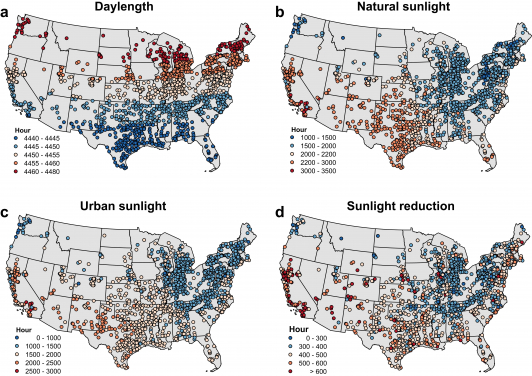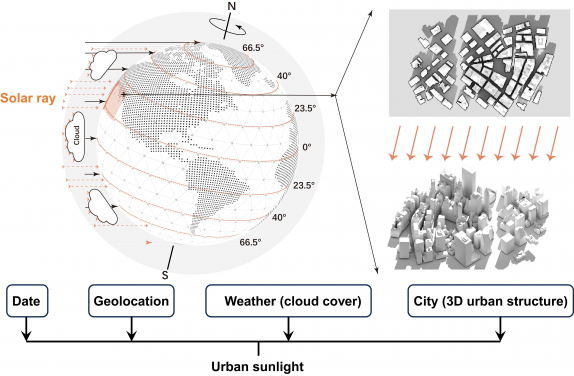Media
HKU remote sensing, landscape and economic scholars jointly reveal cloud cover and urban structures drastically reduce sunlight in cities
25 Sep 2024

Annual Sunlight Maps for 1,353 U.S. Cities in 2020: a) Day Length: Sunlight duration from sunrise to sunset. b) Natural Sunlight: Actual sunlight owing to cloud cover. c) Urban Sunlight: Sunlight over built-up areas. d) Sunlight Reduction in Built-Up Areas: Difference between natural and urban sunlight due to 3D urban structures.

Sunlight in 3D Cities: Shows how date, location, weather, and city structure affect sunlight using cloud cover and 3D data.

Annual Sunlight Maps for 1,353 U.S. Cities in 2020: a) Day Length: Sunlight duration from sunrise to sunset. b) Natural Sunlight: Actual sunlight owing to cloud cover. c) Urban Sunlight: Sunlight over built-up areas. d) Sunlight Reduction in Built-Up Areas: Difference between natural and urban sunlight due to 3D urban structures.
- 1 / 2
- 2 / 2
Sunlight plays a crucial role in public health, affecting vitamin D synthesis and psychological wellbeing. Inadequate exposure to sunlight is associated with various adverse health outcomes, such as cardiovascular diseases, metabolic syndrome, depression and mental disorders.
The ideal sunlight, or baseline, represents the maximum amount of sunlight a region would receive annually in the absence of cloud cover or urban structures, approximately 4,460 hours. Urban development, especially skyscrapers, can block natural sunlight, reducing exposure by up to 90% in high-rise cities like Hong Kong. This lack of sunlight contributes to health issues such as vitamin D deficiency and myopia, particularly among children and the elderly. The rapid rise in tall buildings since the 1970s has exacerbated the problem, highlighting the need for urban planning that ensures adequate sunlight for residents.
Recently, researchers from HKU have developed a framework to assess sunlight duration in cities, revealing a substantial reduction in available sunlight owing to cloud cover and three-dimensional urban structures. The findings have been published in Nature Cities, underscoring the imperative for integrated approaches to urban planning that emphasize sufficient access to sunlight.
Existing studies often overlook the details of how three-dimensional urban structures and cloud cover together affect sunlight availability. The research team synthesised a suite of remote-sensing data and process-based models, related to urban built-up areas, cloud observations, urban structure parameters and climatic conditions — representing a “digital twin” of the urban environments — to evaluate sunlight dynamics across 1,353 cities in the United States for the year 2020.
Applying this framework to 1,353 US cities, the findings reveal a significant decrease of 2,896 h (121 days) in available sunlight for 2020, with cloud cover accounting for 2,448 h (102 days) and urban structures contributing to a 448-h (19-day) loss.
Nationwide findings reveal that cloud cover and urban structures significantly reduce annual sunlight hours. Cloud covers alone account for a 55% reduction in sunlight, translating to 102 days of lost sunlight annually. Urban structures contribute an additional decrease of approximately 19 days annually.
Notably, the effects of cloud cover are more pronounced in northeastern regions (such as Maine and New York) and northwestern regions (such as Washington), where annual sunlight hours decrease from 4,460 to 1,500. Furthermore, urban shading impacts show distinct geographic variations, with more severe patterns in coastal cities.
Professor Bin Chen, the project’s principal investigator and Assistant Professor of Division of Landscape Architecture at HKU said: “This study grows out of our earlier research published in 2023 in Nature (link), about optimising urban shade using digital twins , and aiming to investigate the interplay between nature and three-dimensional urban structures that limit sunlight availability.”
Professor Chen emphasised two important contributions from this study and said: “The developed conceptual model enables us to account for various factors, including latitude, cloud cover, seasonal variations and urban structures to the sunlight duration; this is crucial for capturing the complex interplay between geographic, climatic and structural elements that affect sunlight exposure in densely built-up urban areas. Another key insight is that the cumulative impact of these factors leads to a total annual reduction of 2,896 sunlight hours, equivalent to 121 days.”
“With the observed increasing trends in cloud cover and urbanisation, sunlight loss is likely to worsen.” Professor Chen remarked that the study highlights the pressing need for interdisciplinary urban planning strategies that prioritise adequate access to natural sunlight.
"Rapid urbanisation and the increase in tall buildings have profound implications for both energy management and public health. The sunlight loss could exacerbate energy demands and increase carbon emissions, particularly in colder regions and during colder seasons. We need localised regulations to ensure fair access to sunlight in high-density areas," said Professor Chen Lin, Chair Professor of Finance, Associate Vice-President at HKU.
Professor Peng Gong, Chair Professor of Global Sustainability at Department of Geography and Department of Earth Science, Vice-President and Pro-Vice-Chancellor (Academic Development) of HKU, commented: “This study emphasises the life-giving and essential role of sunlight exposure for city dwellers. The empirical evidence underscores the substantial and geographically variable impact of both natural and urban factors on sunlight availability. Interdisciplinary collaboration is essential to developing a comprehensive cost-benefit framework to optimise strategies in urban structure design and maximise overall benefits.” He stated that HKU is proactively contributing to scientific research and practice in support of achieving the UN’s Sustainable Development Goals, noticeably, launching two research hubs - Urban Systems Institute (USI) and Institute for Climate and Carbon Neutrality (ICCN).
The full paper can be accessed here: https://www.nature.com/articles/s44284-024-00120-x
About the Research Team
The research was led by Professor Bin Chen, Director of Future Urbanity & Sustainable Environment (FUSE) Lab, Division of Landscape Architecture, Faculty of Architecture, HKU. The collaborative team includes Dr Shengbiao Wu, Research Assistant Professor, FUSE Lab, HKU; Professor Jiafu An, Department of Real Estate and Construction, HKU; Professor Chen Lin, Faculty of Business and Economics, HKU; and Professor Peng Gong, Department of Geography, Department of Earth Science, and Urban Systems Institute, HKU.
This study is supported by The University of Hong Kong HKU-100 Scholars Fund, Seed Funding for Strategic Interdisciplinary Research Scheme, the Research Grants Council of Hong Kong Early Career Scheme (HKU27600222), General Research Fund (HKU17601423) and Theme-based Research Scheme (T35/710/20R), National Key Research and Development Program of China (2022YFB3903703), National Natural Science Foundation of China Young Scientists Fund (42201373), the Croucher Foundation (CAS22902/CAS22HU01), and HKU Start-up Fund for Professoriate Staff.
About the FUSE Lab
FUSE Lab aims to leverage geospatial and remote sensing big data, data-model fusion, and advanced interdisciplinary approaches to investigate the interaction loops between urban environmental change, human activities, and public health, with the ultimate goal of contributing to sustainable development. FUSE lab’s research focuses on four primary directions: (1) Urban and Natural Environmental Changes; (2) Human-Environment Spatiotemporal Interaction; (3) Impact of Human Activities and Environmental Changes on Public Health; and (4) Urban Environment Improvement Theory and Adaptation Pathways.
To promote knowledge exchange, more recent research activities can be viewed through https://fuselab.hku.hk/
For media enquiries, please contact:
Communication and Public Affairs Office, HKU
Melanie Wan (Tel: 2859 2600 / Email: melwkwan@hku.hk)
Jaymee Ng (Tel: 3910 3612 / Email: ngjaymee@hku.hk)
Kenneth Choi (Tel: 3917 2607 / Email: khkchoi@hku.hk)
